Celebrating a Vision
Matt Drury

Photo by Jack Sorokin
My relationship with the A.T. is both personal and professional, and the lines are frequently blurred. The A.T. is a footpath that connects many of my beloved places in the southern Appalachians, often serving as the vantage point or the backdrop as I interact with the landscape. I also appreciate that this vast, protected landscape is often the viewshed I see when fishing, hiking, and mushroom hunting on adjacent lands.
I often pose this rhetorical question when making natural-resource presentations: “What is the value of a national scenic trail that traverses a compromised and degraded landscape?”
I consider the A.T. the backbone of conservation in the East. The establishment of the A.T. and subsequent relocations has led to the protection of tens of thousands of acres of public land, including such iconic places as the Roan Massif and Max Patch. These protected lands provide cover and forage for pollinators and neotropical migrant songbirds, critical corridors for the movement of wildlife, and opportunities for recreation and reflection for millions of people.
I find solace in the protection of these lands and the connectivity they provide when contemplating development patterns and societal challenges, and I find comfort that it is a place where people can simply go and take a walk in the forest, for quite a long distance if they care to.
Through my natural-resources management work for the Appalachian Trail Conservancy (ATC), I have the honor of returning to my project sites many times in a year and many times over the years. I am fortunate to get to know these areas with such intimacy that I feel a connection to individual trees, rocks, and plant populations and can detect the subtleties of forest succession.
When species, habitats, and ecosystems decline or disappear from the A.T. landscape, I believe the intrinsic values of the Trail are at stake. Habitat loss is the leading cause of species extinctions, and habitat loss can even occur on “protected” land. This can be attributed to issues like the spread of nonnative, invasive species or past management practices, such as poorly planned timber harvests and misguided fire suppression. Work we undertake at the ATC aims to restore those compromised areas and protect the incredible biodiversity present along the Trail.
